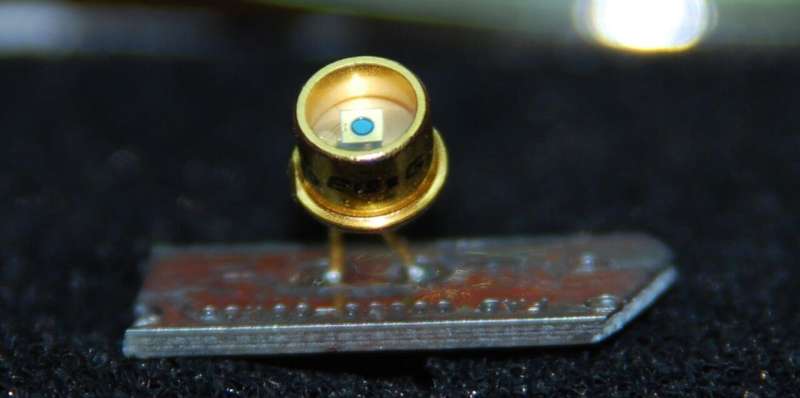Science
Researchers Enhance Avalanche Photodiodes for Better UV Detection

Geiger-mode avalanche photodiodes (GM-APDs) have taken a significant step forward in their ability to detect ultraviolet (UV) light, as researchers have developed a new design aimed at improving their sensitivity to specific wavelengths. Published in the IEEE Journal of Quantum Electronics on November 4, 2025, the study by Dr. Jonathan Schuster and his team at the DEVCOM Army Research Laboratory, United States, introduces a numerical model that could enhance photon detection in the near-ultraviolet (NUV) range.
GM-APDs are highly sensitive detectors capable of identifying single photons. They operate through a mechanism called impact ionization, where photons absorbed by the photodiodes generate electron-hole pairs. When avalanche photodiodes are biased beyond their “breakdown voltage,” these ionizations can reach a self-sustaining level, resulting in detectable electrical pulses. For effective photon detection, these devices must achieve high absorption probabilities at specific wavelengths, which is quantified by their unity-gain quantum efficiency (QE).
The study highlights that certain GM-APDs made from 4H-silicon carbide (4H-SiC) are particularly efficient in detecting photons around 280 nanometers. However, to capture higher wavelengths where absorption diminishes, improvements in baseline photon capture efficiency are necessary. Researchers typically increase the thickness of the absorber layers to enhance detection, but this adjustment often leads to design complications.
Dr. Schuster’s team faced this challenge head-on by developing a model that incorporates a calibrated 4H-SiC material library. They found that to enhance NUV response, APDs with significantly thicker absorber layers—up to tens of microns—are required. This shift necessitates moving from the conventional PIN architecture to a new structure known as separate-absorption charge-multiplication (SACM).
Dr. Schuster explains, “APDs with much thicker absorber layers must be utilized to improve the NUV response, which necessitates switching from a conventional PIN architecture to a SACM architecture. However, this involves unique challenges such as deviating from existing front-side absorber SACM architectures to a very thick backside one.”
The research team designed SACM APDs with two architectural configurations: non-reach-through (NRT) and reach-through (RT). Each design has its specific considerations. The NRT-SACM architecture achieved a unity gain QE of up to 32%, while the RT-SACM design reached an impressive 71% for photons with a wavelength of 340 nanometers. Both designs also maintain a robust electric field in the multiplication layer, essential for Geiger-mode operation.
The study underscores the need for careful engineering of doping profiles in NRT-SACM designs to balance two competing mechanisms: maximizing the minority carrier diffusion length in the absorber layer while minimizing potential barriers at the absorber layer/charge layer interface. In contrast, the RT-SACM architecture requires precise modulation of the total charge in the charge layer to ensure a sufficiently high electric field for avalanche breakdown.
The findings offer a pathway to improving the performance of GM-APDs for applications in the NUV wavelength range. These photodiodes can be utilized in various fields, including solar-blind UV detection, combustion monitoring, and environmental UV monitoring.
The advancements made in this study could lead to the design of more sensitive and efficient APDs, significantly broadening their application scope. The numerical model serves as a valuable tool for future research aimed at enhancing photon detection capabilities.
For more information, refer to the full study by Jonathan Schuster et al. in the IEEE Journal of Quantum Electronics.
-

 Entertainment2 months ago
Entertainment2 months agoAnn Ming Reflects on ITV’s ‘I Fought the Law’ Drama
-

 Entertainment3 months ago
Entertainment3 months agoKate Garraway Sells £2 Million Home Amid Financial Struggles
-

 Health2 months ago
Health2 months agoKatie Price Faces New Health Concerns After Cancer Symptoms Resurface
-

 Entertainment2 months ago
Entertainment2 months agoCoronation Street’s Carl Webster Faces Trouble with New Affairs
-

 Entertainment2 months ago
Entertainment2 months agoWhere is Tinder Swindler Simon Leviev? Latest Updates Revealed
-

 Entertainment3 months ago
Entertainment3 months agoKim Cattrall Posts Cryptic Message After HBO’s Sequel Cancellation
-

 Entertainment2 months ago
Entertainment2 months agoOlivia Attwood Opens Up About Fallout with Former Best Friend
-

 Science2 weeks ago
Science2 weeks agoBrian Cox Addresses Claims of Alien Probe in 3I/ATLAS Discovery
-

 Entertainment3 months ago
Entertainment3 months agoMarkiplier Addresses AI Controversy During Livestream Response
-

 Entertainment2 months ago
Entertainment2 months agoMasterChef Faces Turmoil as Tom Kerridge Withdraws from Hosting Role
-

 Entertainment4 months ago
Entertainment4 months agoSpeculation Surrounds Home and Away as Cast Departures Mount
-

 World2 months ago
World2 months agoCole Palmer’s Mysterious Message to Kobbie Mainoo Sparks Speculation





















